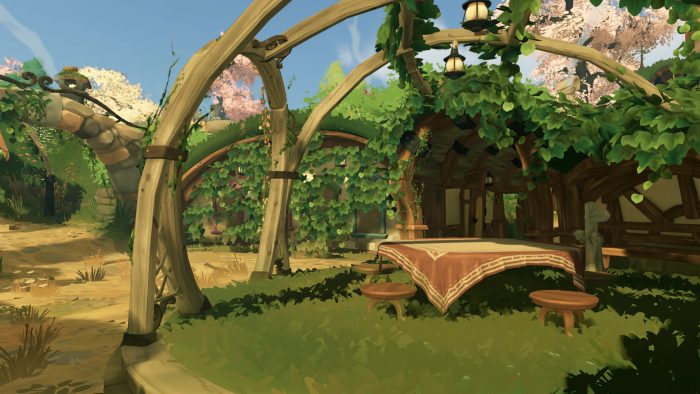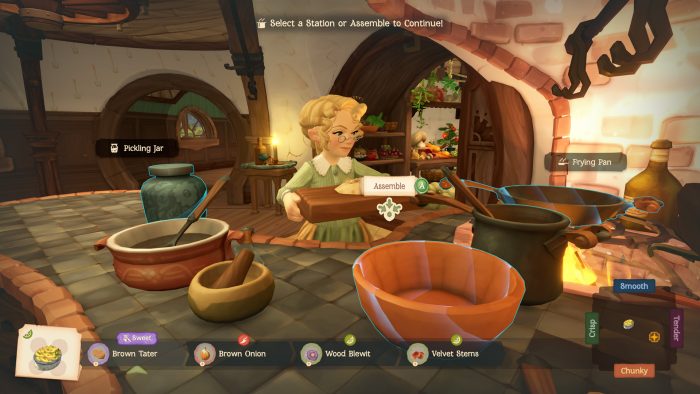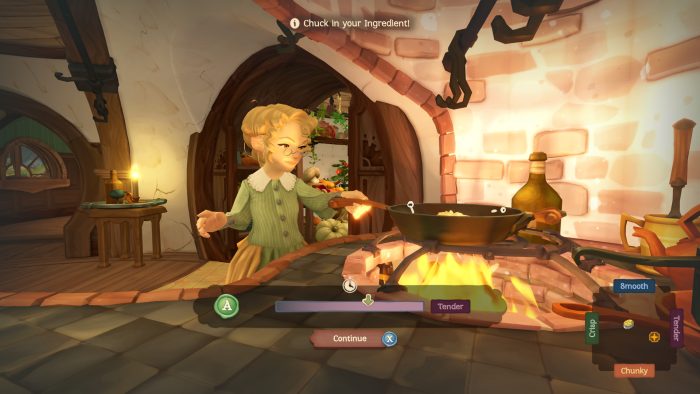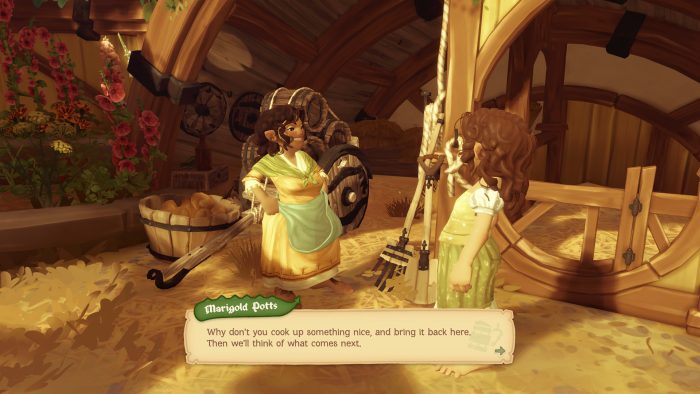Hands on with the lovely, oblivious life of a hobbit
I’ve watched the Lord of the Rings films. I’ve read some of the books and played some of games. But I am not the deepest LOTR fanatic. I enjoy it, I know enough to be dangerous, but I’m not illegal.
That being said it doesn’t take any knowledge whatsoever to appreciate and have fun with Tales of the Shire, the new game from Wētā Workshop Game Studio that puts us in the, uh, feet of a hobbit tasked with putting a town on the map.
At Summer Game Fest last week, I had the opportunity to go hands on with the latest build of the game, and by the time I was done I felt like I had slowly morphed into the hobbit that I was supposed to be playing. Tales of the Shire is a narrative, cosy life story. It’s not so much a sim as a game that uses sim elements to draw us into the world of Middle-earth, and hobbit life especially. I spoke to Kurt Adams, 3D Artist for the game, to better understand what the project is about. His synopsis is simple: it’s the day in the life of a hobbit.
Shire takes place between the events of The Hobbit and Fellowship; there’s awareness of the events of The Hobbit, but no one is looking for the Ring. Instead the hobbits are going back to their secluded lives, going back to work, back to their routines because that’s what they know and what they want. They are happy being oblivious. The game isn’t designed to change or even give depth to any of the events of the series. It’s a story that can be appreciated as a part of the timeline without ever affecting it.
That’s hobbit life in a nutshell, and why we’re not playing a specific person in the universe.
In fact, the game’s character creator even goes so far as removing gender as an option. This allows us to just be a “hobbit” instead of worrying about the trappings of what a male or female hobbit must do — because really, they all do the same thing and they all want the same thing: community, friendship, connection to nature. We can make our own name or use pre-generated first and last names that fit within hobbit lore. We can even set up our general mood. Happy? Grumpy? Some days we just want to be a grumpy hobbit. The artists worked with Wētā to develop clothes and fabrics, going deep into how materials would lay on shoulders and hips, how they would be made (hand-stitched?) and how they would feel. Fun side note: did you know that hobbits don’t have facial hair? I didn’t, but that’s a key aspect of the lore. So, when the artists first explored facial hair as an option they realized that no, it just wouldn’t fit into what a hobbit is. Foot hair, though, that’s a whole other story.
Adams notes that the team wants the project to be a cozy game. The art style aims to fit the mood of what they’re trying to capture, which is the stories (tales!) of the people in the Shire. Aesthetically it’s not like the films, it’s more of a storybook. It’s painterly, almost dreamlike. It’s a welcoming, vibrant space that we want to be in and interact with, a place that stays bright and full of color even when the seasons change. It has lush grass that we can run through and forage, lots of overgrowth that we can play in, and cobblestone streets and woodworked buildings that looks like they may fall over if a big gust of wind blows through. Working directly with Wētā Workshop, who have 30 years of history with the world of Tolkien and know it inside out, means that every detail has been checked over and over to make sure it stays true. And, working with Middle-Earth Enterprises also meant that everything would be a conversation, from the writing to the history behind, well, everything. All of the parties involved had to fact check everything from colors, to plants, to things like snow — is there snow in the Shire? How much? Do they get glacial drifts, or just light flurries? And if we can build a snowman, why doesn’t snow collect too deep, making the ground chilly more than anything? Details! The dev team knows that players would be fact-checking every detail, so they wanted to make sure they did it first. The Lord of the Rings has some of the most dedicated fans that will go deep into the lore of every aspect. It’s a daunting but enjoyable process.

Speaking of the reality, it goes to the design of the hobbits themselves. Hobbits are known for their big feet, so when they walk they tend to go foot first, leaning back because their lower body momentum guides them. The animators had a lot of fun creating things like different character walks, and how their animations reflect on their physical and mental states. When the hobbits walk, they might walk feet first, but when they run they sort of skip. They love life and want to enjoy every aspect of it. Running doesn’t need to exist here. To gain any speed we need to go downhill — that’s where our feet and bodies will take us. The team really wanted movement to feel good and fun.
As my demo begins, we’re dropped off by Gandalf at the town of Bywater and been given a map by Bilbo to find our new home. We’re on the road leading into and out of town, but since a cart and a cow have gotten stuck there, it means we’re not leaving. We’re stranded, but that’s okay in this idyllic little hub. In town we meet a local hobbit named Orlo, who shows us to our home, Old Ruby’s place. There’s a bit of mystery here. The place is run down, but we’ve inherited it and need to bring it back up to life and make it our own, make it warm and inviting. We don’t start off completely empty handed, as there are still some things in the house left behind to get us started, but there are also little secrets like locked drawers, unknown items on shelves. The house gives us the things we absolutely need to survive, but we can look forward to opening up and expanding the story of the home. This includes and requires working with the other hobbits, who will help us expand the house, the garden, and our place in town.
Hobbit life is communal, and because it’s communal, cooking and sharing meals is a big part of it and a big part of the game. The cooking is fun; there are stations throughout the kitchen for different parts of the process. Once we pick out our recipe (in the demo we have a sort of beginner’s porridge) we start by putting the collected ingredients into a pot. There are aspects to getting a quality end result, presented by a slight puzzle matrix in the corner that shows where the meal is in terms of flavor and texture. Is it chunky and smooth? Crisp? Tender? Some recipes need more cooking time, others need less. We can watch this matrix and make sure we’re doing things right. Our meal starts in the middle of the matrix, and its sweet spot is in the top right, so we manipulate the cooking process to get it as close as possible. We can’t get perfection on our first meal — we don’t have the talent or experience in the game yet — but imagine anyone making a new recipe for the first time. It’s not always easy, and takes practice. In this game as we learn we open up more aspects to the cooking that helps us get to that sweet spot. That gives us a little more depth than the usual meal prep minigames. It’s not just about rushing through. In fact, the game makes it a point not to rush through anything. From cooking to gardening, doing our daily chores. It’s a leisurely life.

After our porridge is complete we find Orlo, who’s been sitting and waiting, rubbing his hands the whole time. The game lets us invite other hobbits to our house, and we can even have a meal at the Green Dragon and Ivy Bush and secret locations, too. And the better our cooking, the more delicious our food and the better reactions we get, which help us forge relationships and unlock more of what our neighbors can do for us. It’s a bit about making bonds with the people we meet. We do things for each other, and they give us items and gifts. So instead of grinding for money, the game is more about working together for rewards, which are based on the characters’ individual stories. The dev team wants the players engaged with the world, so hooking them with these stories, these “tales”, is key. So much so that they had a lot of fun writing them and even baking in a lot of laughs and jokes. The game has a postal system, too, so other characters can send us mail throughout the day to thank us, invite us to events, etc.
Adams mentions having a lot of fun creating the world itself. That starts with the locations on the map. Because there aren’t dedicated maps for many of the aspects of this town, it involved a lot of reading for details. For instance, he used the Battle of Bywater as a landmark, and knowing where it took place within the town helped understand where some of the paths leading up to it would be. He used lore-filled details like the ruffians coming up the Great East Road, and then heading along to Bywater Road, off South Lane. That put specific things in specific locations, and once those landmarks were all in the empty spaces started to reveal themselves, showing where the player’s house and many other locations could be. It was a long process, but he slowly started filling everything in. One fun aspect that Kurt loves to talk about is that Hobbits have roads, sure, but they also like to make their own paths through the grasses, through brambles, where they pick blackberries. So, in order to not get lost in the thickets and grasses, the team developed a system where birds will appear and land on key points of navigation, like signposts and mailboxes. It’s a really natural way of hinting at where to go next. A big glowing arrow wouldn’t be true to the world, as the HUD needs to be integrated. What’s the hobbit version of a HUD? Birds for paths, butterflies for forageables. Nature, basically. I especially love the nature sounds in the game. Birds are chirping, water is rushing in the creek. The music is even tilted toward the natural aspect.

After our meal we eventually head into town, where people are more or less minding their own business. We can talk to merchants, regular folk, to animals, too. We need to make coming to town a regular thing in the game to buy ingredients, trade, and forge relationships. And to engage in the clubs that we can join, like cooking clubs, fishing, and more. Apart from our daily hobbit duties there are a lot of club missions to keep us active, and by doing the things we want to do in the clubs we can get rewarded. We like fishing? We’ll keep getting new rods and finding new fish. Cooking? New recipes. Anyone we meet can be tracked on our map, with details about where they live and what they’re doing. We can kind of learn their schedule, which becomes important for advancing our relationships and the town.
After enjoying the town center I skip back to my home to try out gardening. Gardening lets us grow items from seeds, and having a beautiful garden is key to relationship building. A big part of the game is beauty and decoration, and the mode dedicated to it is impressive. We can not only buy and place items, but we can adjust where they go, change their colors and even their materials, right down to things like the trim and floorboards in our home. The house can really become a reflection of our own style. It’s a grid-free system of placement. A chunk of the game’s art development was making sure everything worked to scale and position and lighting, so that things don’t look out of place wherever you place them, like bringing some of our items from inside of the house to the outside. Have you ever dreamed of a bookshelf next to a fruit patch? I have. We can even put things *on* things, like cushions on couches, or books on shelves, or books on couches and cushions on shelves. It’s a deep system of customization that will undoubtedly have fans take it to extreme levels of personalization.

There are four major acts in Tales of the Shire, and one of the biggest goals is to put Bywater on the map. It may seem small in comparison to what we know of the LOTR mythos but it fits in perfectly with hobbit life. We essentially want to be big enough to have Gandalf come back and celebrate with us. What more could we want as a hobbit besides a wizard who brings fireworks?
Tales of the Shire releases later this year on Nintendo Switch, Xbox Series, PlayStation 5, Netflix Gamesa and Steam.









![[Hands-on preview] Tales of the Shire gives a welcome peek into Hobbit life](https://www.sidequesting.com/wp-content/uploads/preview-tales-of-the-shire.jpg)

No Comments